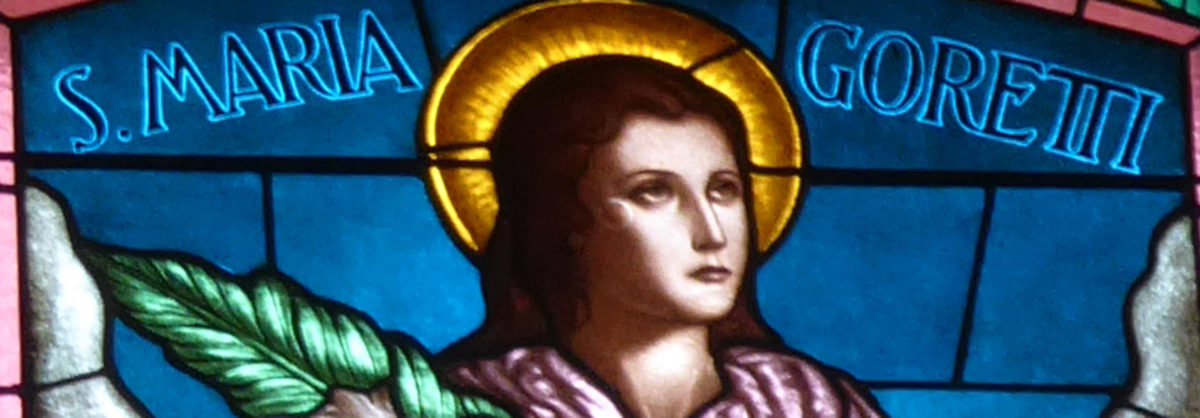It was not until I began my middle school teaching career that I found the story of St. Maria Goretti particularly striking, not to say, disturbing. The unquiet I felt at Maria’s suffering and the appalling circumstances surrounding her death was compounded by her almost shocking courage and holiness.
And that’s the question: how can we relate to Maria when her sanctity seems so far out of our reach, the manner of her death so unjust and obscene? I look at my students and it terrifies me that they are the same age as Maria when she was attacked and murdered. I even wonder how God can allow such terrible things to happen. Christ’s anguished words on the cross come to mind:
“My God, my God, why hast thou abandoned me?”
On deeper reflection, however, I have come to realize that Maria Goretti just might be the perfect saint for our time. In a world where almost every day we see the shameful uncovering of countless crimes against the innocent, perhaps the story of Maria Goretti is exactly what the world needs.
Maria Goretti was born in Italy in 1890 and died at the age of 12, about the same age as my seventh graders. Like my students, she was on the cusp of adolescence with her whole life before her.
Maria was one of six children born to a poor Italian tenant farmer. Her father died when she was nine years old. To continue providing for the family, Maria’s mother and siblings worked with a man named Giovanni Serenelli and his teenage son, Alessandro, in the fields of a Count.
Like many poor girls of her time, Maria did not receive a formal education and could not read and write. But she had a deep faith and devotion to Our Lady, reciting the mysteries of the Rosary nightly for her father’s soul.
Alessandro began verbally and emotionally abusing Maria by making crude and degrading remarks. On July 5, 1902, he told her to mend his shirt. As she was sewing, he dragged her into his bedroom and attempted to rape her. She resisted and in his rage he stabbed her 14 times.
In the hospital, doctors attempted to save her from her wounds without the aid of anesthesia. She remained conscious throughout the whole ordeal. Remarkably, when she was asked if she forgave Alessandro, she said “Yes, for the love of Jesus I forgive him… and I want him to be with me in Paradise.” After receiving the viaticum, Maria died 24 hours after the attack. She was only 12 years old.
Maria’s suffering rightly turns our blood cold. Nothing can minimize the horror of her murder. Like the Women of Jerusalem watching Christ stagger under his cross, bleeding and exhausted, we also weep to see such innocent suffering. And like Peter cutting off the ear of the servant of those who came to arrest his Lord, we rail at the evil of a world that could inflict such pain.
Yet like the Crucifixion, we must have the faith to look suffering squarely in the face; we must remain at the foot of the cross, our sight set unblinkingly on Christ. This is what Maria did—she kept her eyes fixed on the One who not only saves but forgives, the One who said:
“Father forgive them for they know not what they do.”
At first it seemed as if Maria’s forgiveness of Alessandro had no effect. Throughout his trial and subsequent imprisonment, he remained hardened to his crime, claiming he was innocent. Several years into his sentence, however, spiraling into despair and a declining mental state, Maria appeared to him in a dream. Smiling and surrounded by lilies, she told him she had forgiven him.
After this vision, Alessandro repented and converted. He willingly fulfilled the rest of his sentence, knowing that it was just punishment for his sins, and when he was released, he entered a Capuchin community as a lay servant to the brothers.
Alessando also went to Maria’s mother and asked for her forgiveness and the pardon of the entire parish. Eventually, he and thirty others gave testimony for Maria’s canonization, and with 250,000 faithful gathered in St. Peter’s Square, he knelt in veneration at her canonization on June 24, 1950.
Alessandro was perhaps the most convincing proof of Maria’s sanctity, a testament to hope for troubled young people at their worst. Although justice demands retribution for such a terrible crime, grace calls us to forgive. This is what Maria did and what she would pray for us to do when confronted with unspeakable evil. This is what Jesus did from the cross, just as Mary surely forgave her son’s tormentors and murderers.
In her forgiveness of Alessandro, Maria’s mother was able to imitate the Blessed Mother.
As a teacher and spiritual mother of young people, much like St. Elizabeth Ann Seton herself, I pray that I might always look at those students in my care with compassion, forgiveness, and charity; I pray that I may never give up on any of my students no matter how badly they behave, that I may always look on them with the loving and forgiving eyes of God and His saints.
When Mother Seton instructed her Sisters on educating the children spiritually entrusted to them, she would exhort them to “form [their] tender minds” to “piety and sound morals.”
St. Maria Goretti perfectly fulfilled Mother Seton’s desire that we ought to live “in His presence and love,” so that “we will die thinking of Him and loving Him.”
I like to think that Maria Goretti would have been Mother Seton’s most beloved pupil and daughter.
Christina O’Brien’s writing has appeared in VIGIL Magazine, the Young Catholic Woman, The Catholic Woman, and America Magazine.
Image: St. Maria Goretti stained glass at San Felice Church, Trentino, Italy
This reflection was previously published. To read all the Seton Reflections, click here
